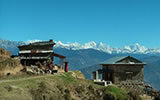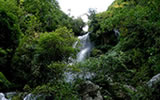Nagarkot
Nagarkot, at 2175m above the sea level, is the most popular resort destination in the Kathmandu Valley. It is the favorite weekend gateway among those seeking Mountain View in comfort and silence. It is also one of the best spots to visit for unmatched sunrise/sunset views. At sunrise, the Himalayan range, stretching from Dhaulagiri in the west all the way past Everest to Kanchanjunga in the east, emerges from the darkness to greet the happy visitors with its awe inspiring majesty and beauty. For those wishing to stretch their legs and enjoy the fresh morning air, there are charming walking trails as well as a lookout tower from which the sights can be taken in. Blessed with a cool and pleasant climate all year round, Nagarkot is a treat for the tourists in any season.
Changunarayan (World Heritage Site)
Changunarayan is the temple of Vishnu, the Preserver, in the village of Changu in Bhaktapur. The origin of Changunarayan goes back to the 4th century. A 5th century stone inscription in the temple proclaims it as one of the oldest shrines of the Kathmandu Valley. The temple is believed to be 1600 years old. It is embellished by the best examples of stone, wood, and metal craft. On the struts of the two-tiered Changunarayan Temple, are the ten incarnations of Narayan. A 6th century stone statue shows the cosmic form of Vishnu. Garuda, half man and half bird, is the vehicle of Vishnu, and his life-sized statue kneels before the temple.
Dhulikhel
Dhulikhel is a typical Newari town with nearby Tamang villages. It is situated 30 km east of Kathmandu on the side of Araniko Highway on the way towards Tibet. Dhulikhel is popular for its natural beauty and ancient traditions. The Himalayan ranges from the twin crest of Mt. Langtang in the west to the Mt. Everest in the east, can be clearly viewed in a clear day. Dhulikhel is ideal for snow-capped peaks, sunrise, sunset and it is different from any other place.
 |
Namo Buddha
Namo Buddha means ‘Greetings to the Buddha’. It is the symbol of human sacrifice at the highest possible level. A legend has it that a prince while hunting in the forest saw a hungry tigress with her cubs. The compassionate prince, seeing the pitiable conditions of the starving animals, cut the flesh of his body and feed them. Such an extra ordinary deed of the prince led him to be a Buddha at the site where he feed his flesh to the animals. The main stupa dedicated to Namo Buddha depicts this story of selfless action of the prince. Namo Buddha has always drawn reverent pilgrims. One can drive up to Dhulikhel from Kathmandu and can choose either to further drive on the rough road or hike up to Namo Buddha.
Panauti
It is a small rural town situated at the confluence of two rivers at the end of a pleasant valley dotted with traditional farmhouses set on hillocks above the fertile rice fields. In the old part of the town we find several interesting old Newari houses and temples. The large main temple called Indreshwori Mahadev Mandir, constructed in 1294, is one of the oldest Shiva temples of the whole area.
Lubhu
Lubhu is located south-west of Patan along a rough road which passes many brick-making factories with their small chimneys. The village still retains a rural feel, with grain scattered across the road during harvest times. It is a perfect place for self-discovery in the rural setting. The main three-tiered temple lies in a courtyard and is devoted to Mahalaxmi, the female consort of Bhairav. Other more interesting sights are the many family-run weaving yarn mills throughout the village, often found inside the dark and small old houses.
Godavari
It is an open place with a small village at the foot of Phulchowki Hill. Here, we find a Botanical Garden with orchids in particular and many other Himalayan plants. Rhododendrons adorn the Phulchowki Hill in spring. Hindu pilgrims gather at the sacred festival held every twelve years. Phulchowki Mai is the mother goddess of the forest and a shrine is being erected here in her honour.
Phulchowki
Phulchowki, meaning ‘Hill of Flowers’, is located at an altitude of 2762m above sea level, 20 km to the south-east of Kathmandu and is the highest point or the tallest hilltop surrounding the Kathmandu Valley. It commands a grand view of the entire Kathmandu Valley with a backdrop of the Himalayas to the north and the Terai plains to the south. The forested slopes are full of rhododendrons, orchids and other green vegetation. Deer, bear, leopard and more than 250 species of birds have been already recorded in Phulchowki.
Khokana
It is another unspoilt Newari Village to step back in time. Here, you will find a three-tiered temple of goddess Shekali Mai and traditional oil-making activity in the village. From Khokana it is possible to do a very enjoyable trek to Pharping and Dakshinkali.
Bungamati
It is a lovely Newar village situated about 10 km south of Kathmandu. The village has retained a very pleasant atmosphere and is still almost completely untouched by modernization. Life goes on much as it has for centuries; people draw water from wells, dry corn, rice and millet, children running around everywhere.
Dakshinkali
Dakshinkali is one of the very popular pilgrim sites for the Hindus and is quite crowded especially on Tuesdays and Saturdays when animal sacrifices are offered. It is located about 22 km to the south of Kathmandu. Goddess Kali is a Tantric deity and is the symbol of power and authority. A trip to this beautiful location combined with Chobhar Gorge from where all the waters of Kathmandu Valley drain out is quite a rewarding experience.
Champa Devi
The hike to the top of Champa Devi (2278m), the highest peak on the Chandragiri Ridge south-west of Kirtipur, affords a panoramic view of the west Kathmandu Valley, back dropped by the snow covered Himalayas. Either starting from Chobhar or from Pharping, the trail climbs steeply to join at a saddle close to the top. A Hindu shrine and a white stupa mark the Champa Devi summit.
Kirtipur
Kirtipur is a small town located 8 km south-west of Kathmandu on the top of a ridge. Tribhuvan University lies at the foot of the hill. This historic town has many things to offer including ancient shrines, temples, old-style houses, and villagers dressed in costumes and weaving of hand looms.
Daman
It is situated 80 km south-west of Kathmandu, midway to Hetauda on the Tribhuvan Highway, at an altitude of 2322m. For the view of the breathtaking grandeur of the world's highest peaks extending in one glittering from far-west of Dhaulagiri to far-east of Mt. Kanchanjunga, there is no better place than Daman. And if you're feeling adventurous, this is one of the most spectacular and grueling mountain-bike routes in the world.
Nagarjun
Nagarjun, also known as the Jamachowk, is the forested hill which lies to the northwest of the Swayambhunath Stupa. It is named after a famous sage. It is about 10 km from Kathmandu city. There is a Buddhist shrine at the top which is very holy for both Buddhist and Hindus. To reach the top one has to climb for about 15 to 20 minutes. From this point a panoramic view of the Himalayan ranges can be seen. Leopard, deer, birds, squirrel, and other animal species may be seen and the hill tracks are perfect for mountain biking as well.
Kakani
 Kakani is situated at a height of 1982m and located 29 km north-west of the Kathmandu city. It has a magnificent view of the northern Himalayan mountain ranges and features beautiful alpine scenery. There is an unusually perfect blending of the imposing mountain scenery with the more sylvan environment of the lower valleys. Rhododendrons growing wild on the mountain slopes begin to bloom in late winter and stay in bloom for several months, giving the village even more charm. Kakani is situated at a height of 1982m and located 29 km north-west of the Kathmandu city. It has a magnificent view of the northern Himalayan mountain ranges and features beautiful alpine scenery. There is an unusually perfect blending of the imposing mountain scenery with the more sylvan environment of the lower valleys. Rhododendrons growing wild on the mountain slopes begin to bloom in late winter and stay in bloom for several months, giving the village even more charm.
Shivapuri
 Shivapuri, the land of Shiva, is about 9 km to the north of Kathmandu. There is a great view of the central Nepal Himalaya and the Kathmandu Valley from the hilltop at an elevation of 2732m above sea level. The Shivapuri Hills offer great opportunity for Bird watching, animal sightings and short trekking/hiking tours. Being a transition zone between sub-tropical and temperate climates, rhododendrons, black bear, deer, jungle cat, leopard, woodpeckers, eagles and other creatures of the nature can be seen here.
Shivapuri, the land of Shiva, is about 9 km to the north of Kathmandu. There is a great view of the central Nepal Himalaya and the Kathmandu Valley from the hilltop at an elevation of 2732m above sea level. The Shivapuri Hills offer great opportunity for Bird watching, animal sightings and short trekking/hiking tours. Being a transition zone between sub-tropical and temperate climates, rhododendrons, black bear, deer, jungle cat, leopard, woodpeckers, eagles and other creatures of the nature can be seen here.
|